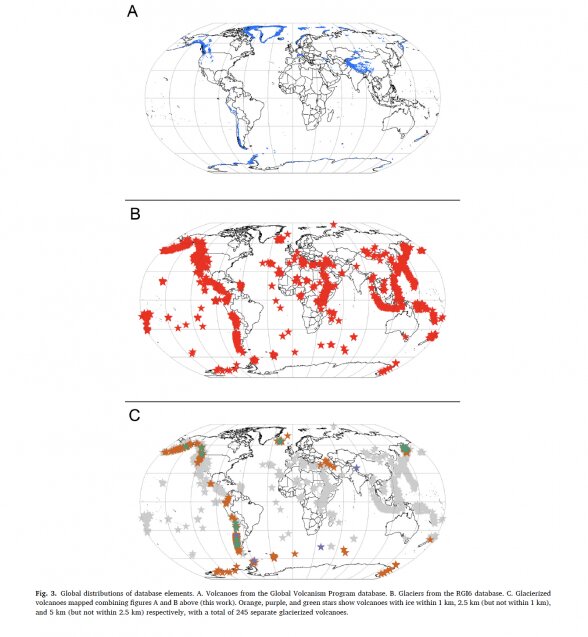#New database maps and classifies the dangers of glacierized volcanoes

“#New database maps and classifies the dangers of glacierized volcanoes”

Destructive volcanic mudflows, huge clouds of volcanic ash that ground flights, and catastrophic floods when natural glacial lake dams fail—these are all examples of the dramatic interactions between volcanoes and glaciers. To help others study, and hopefully predict, dangerous glaciovolcanic activity, researchers have created a new database that combines existing global data.
This study is a valuable resource that could aid further research and also help determine the world’s most dangerous glacierized volcanoes. The study was conducted by Benjamin Edwards, a volcanologist at Dickinson College, William Kochtitzky, a student at Dickinson when the study was conducted, and Sarah Battersby, a research scientist at Tableau Software. Led by Edwards, the volcano expert of the group, the researchers first compiled data on the location of volcanoes and their eruption histories. Kochtitzky, interested in glaciology and mapping, brought together data on glacial ice location, thickness, and volume. To determine the very real dangers this combination could pose, they determined how many people live near each glacierized volcano.
Glacierized volcanoes pose unique risks to human populations. When the red hot lava meets the dense layers of ice, a huge amount of energy is released which can then lead to out of control mudflows, clouds of ash and steam, and glacial outburst floods.
Edwards described the impact that glaciers can have on the frequency and intensity of volcanic mudflows, also known as lahars: “A lahar is a mudflow where most of the material is made out of volcanic rocks and ash. You can have lahars in a variety of settings, but they need water. If you’ve got a volcano with ice on it, there’s a good chance that when the volcano erupts, some of the ice is going to melt. Then you have water and volcanic debris which turns into a volcanic mudflow.”
Glacial lake outburst floods or jökulhlaups occur when a glacial-lake is filled with melting glacial water and the volume of water exceeds what the lake is able to hold. A rapid and catastrophic flood occurs when this intense volume causes a glacial dam to break. When a glacier is subjected to the heat of a volcano, it could melt more rapidly and increase the likelihood of a jökulhlaup.
Human populations can be profoundly impacted by glacier-volcano interactions. To live below a glacier is to face the possibility of a devastating flood or a sudden decline in water supply. “There are 160 million people that live within 100 kilometers of a glacierized volcano,” Kochtitzy told GlacierHub.
Using the database that they created, the research team was able to classify volcanoes based on their potential to harm human populations. “We ranked volcanoes based on how many eruptions they’ve had, how many people live near them, and the volume of ice,” explained Kochtitzky.
While these rankings are not timed predictions of volcanic eruptions and their exact danger, they do provide valuable classifications that can be used to understand which glacierized volcanoes should be watched and studied more carefully. This study is informative for those creating the policies and doing the research that could save the lives of people living near glacierized volcanoes.
This is the first database and Geographic Information System (GIS) mapping of global glacier and volcano data. “No one had actually said ‘these are all of the places on Earth where there are a volcano and a glacier in the same location.’ No one had mapped those before,” study author Kochtitzky told Glacierhub. Another groundbreaking new feature of this study is that it utilizes global data to classify glacierized volcanoes by their potential danger to humans.
The database combines two widely recognized data sources, the Smithsonian Global Volcanism Database and the Randolph Glacier Inventory, to determine the spatial distribution of glaciers and volcanoes. The researchers then used GIS to overlay these two datasets and classify volcanoes within 1 kilometer, 2.5 kilometers, or 5 kilometers of a glacier. This study documents the existence of the world’s 245 glacierized volcanoes.
This study is significant not only for its integration of two databases but also for the precision with which the GIS projections locate each glacierized volcano. “We have a spherical world, but we work on flat computer screens,” Kochtitzy told Glacierhub. “If you don’t translate properly from a flat world to a spherical world, then you get messed up.” By providing accurate mapping of location, spatial proximity, and ice volume, the study was able to more accurately represent glacierized volcanoes.
With this accurate and comprehensive database, the danger that lurks in glaciovolcanic eruptions can be studied and understood, and hopefully, help scientists and decision-makers safeguard the communities that make their homes at the base of these towering mountains of ice and fire.
Crystals reveal the danger of sleeping volcanoes
Benjamin Edwards et al. Global mapping of future glaciovolcanism, Global and Planetary Change (2020). DOI: 10.1016/j.gloplacha.2020.103356
This story is republished courtesy of Earth Institute, Columbia University http://blogs.ei.columbia.edu.
Citation:
Fire and ice: New database maps and classifies the dangers of glacierized volcanoes (2020, November 26)
retrieved 26 November 2020
from https://phys.org/news/2020-11-ice-database-dangers-glacierized-volcanoes.html
This document is subject to copyright. Apart from any fair dealing for the purpose of private study or research, no
part may be reproduced without the written permission. The content is provided for information purposes only.
If you liked the article, do not forget to share it with your friends. Follow us on Google News too, click on the star and choose us from your favorites.
For forums sites go to Forum.BuradaBiliyorum.Com
If you want to read more Like this articles, you can visit our Science category.

